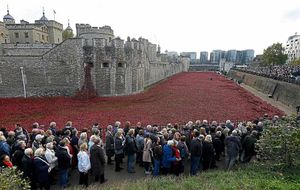Breathtaking poppy show at tower stems from wire-making company
It started with a call out the blue to see if a company run by a man from the Shropshire border could provide a large quantity of wire.
But it ended with the company helping create the breath-taking display of almost 900,000 poppies for the Tower of London tribute to fallen soldiers.
Richard Barnfather, from Pattingham, near Bridgnorth, was approached to see if his company, Barnfather Wire (Midlands) Ltd could create the wire stems for the flowers, which have been seen by around five million people from across the world
Bosses were initially approached by a third party over whether they could supply steel wire which was cut to length in spring of this year - but were given no details about the job.
After agreeing they could fulfil the £75,000 contract it emerged the company in Willenhall Road, Darlaston, was going to be creating the stems for 888,246 ceramic poppies - which were to be attached separately.
Staff today spoke of their pride at being part of the spectacular display, which marks the 100th anniversary of the First World War and had its final poppy planted this week.

It took 100 tonnes of wire and two weeks to get the stems ready, as they were prepared at three different lengths of 450 millimetres, 750mm and 1,000mm.
The material, which is five millimetres in diameter, was put through two special machines called 'wafios' to make them the required length, operated by two workers.
Staff from Barnfather, which was established in 1990, went down to the capital to assess the delivery of the stems and how it would look. They were then taken in two bundles on wooden pallet by lorry.
Mr Barnfather said they were surprised after being informed what they were working towards but proud to have played a part.
"Going back early in the year we had an enquiry to do a quantity of wire cut to length," he said. "At that particular time we were not aware what the specification was. It transpired later."
It became clear before the cutting was undertaken what they were doing it for, but the size of the task when first contacted had made staff think about what the potential order was.
"It raises eyebrows a bit, it is not something you normally expect on a daily basis.
"An order can vary from one tonne to 10 tonne, very seldom you get an order like that in one go."
Mr Barnfather added: "The vast majority of our work goes into the automotive industry. We do a lot of wire cut to length. We did process the order within two weeks."
The 50 year-old, who employs more than 30 people in the wire manufacturing business, has been to see the impact of the fruits of their labour.
"I went down the weekend before, it was quite an emotional thing seeing it all there and for what it represents.
"It is fascinating to see it has generated as much interest as it has. It has touched the nation.
"We were ecstatic when we got the order. We were pleased about it and felt we were doing our little bit.

"We are proud we have done it, it is something we haven't advertised greatly."
The firm has been enjoying success having recently taken over a firm in Belgium.
The artwork, Blood Swept Lands and Seas of Red, at the Tower of London has marked 100 years since the first full day of Britain's involvement in the First World War.
Created by ceramic artist Paul Cummins, with setting by stage designer Tom Piper, 888,246 ceramic poppies have progressively filled the Tower's famous moat over the summer.
Each poppy represents a British military fatality during the war. The poppies have created an iconic landmark and been
A young army cadet laid the final poppy at the Tower during Tuesday's poignant Armistice Day.
Cadet Harry Hayes, 13, was watched by a crowd of thousands at the landmark display as he placed the last of the ceramic flowers, each of which represents a British or colonial war death in the brutal conflict.




